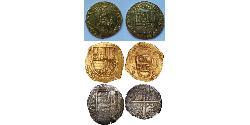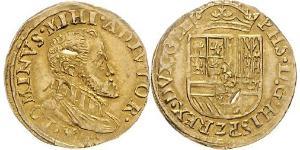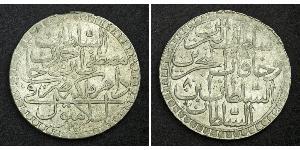(Vendida por $232.0)
1572, Kindom of Naples & Sicily, Philip II. Silver Carlino Coin. Dated Issue!
Mint Year: 1572?
Condition: VF-XF!
Mint Place: Naples
Denomination: Carlino
Reference: MIR 182/8, CNI XX Page 159. Rare!
Diameter: 22mm
Material: Silver
Weight: 2.53gm
Obverse: Radiated head of Philip II of Spain right. Mint official's initials (CR/VP) in left field.
Legend: + PHILIPP DG REX AVT 157Z
Reverse: Cross above inscription in three lines . All within wreath.
Legend: + FIDEI / DEFEN / SOR ("Defender of the Faith!")
Philip II, King of Spain 1556-1598. Son of Emperor Charles V (King Charles I of Spain), founder of the Spanish line of Habsburg. * 1527 Valladolid, - 1598 Escorial near Madrid. Philip II received from his father the following contries: in 1540 the Duchy of Milan, in 1554 the Kingdoms of Naples and Sicily and in 1555/56 the Netherlands, the Franche-Comte and Spain with its colonies. In 1580 Philip also claimed and took over Portugal. He strove for Spanish world supremacy and fought for the counter-reformation. He was married four times: Maria of Portugal (*1526, - 1545 following the birth of Don Carlos), Queen Mary Tudor of England (1554, - 1558), Elizabeth of Valois, daughter of King Henry II of France (1559, - 1568) and finally, in 1570, Anna of Austria, daughter of Emperor Maximilian II. King Philip II fought successfully against France (1557-1559), against the Turks (Juan d'Austria's victory near Lepanto in 1571) and against Mediterranean pirates. However, his attempt to conquer England failed (destruction of the Armada in 1588, sea-battle of Cadiz in 1596), as did his efforts to subdue the revolting Netherlands (secession of the northern provinces). Philip's ongoing war efforts overstrained his financial and economic resources and eventually led to the decline of Spanish supremacy.
The Seventeen Provinces were a personal union of states in the Low Countries in the 15th century and 16th century, roughly covering the current Netherlands, Belgium, Luxembourg, a good part of the North of France (Artois, Nord), and a small part of the West of Germany.
The Seventeen Provinces were originally held by the Dukes of Burgundy of the House of Valois and later by the Habsburg, first by the Spanish and then by the Austrian line.
In 1568 the Seventeen Provinces started a (counter)rebellion against Philip II: the Eighty Years' War. Before the Low Countries could be completely reconquered, war between England and Spain broke out, forcing the Spanish troops under Philip II to halt their advance. Meanwhile, Philip's Spanish troops had conquered the important trading cities of Bruges and Ghent. Antwerp, which was then arguably the most important port in the world, had to be conquered. On August 17, 1585, Antwerp fell. This ended the Eighty Years' War for the (from now on) Southern Netherlands. The United Provinces (the Netherlands proper) fought on until 1648 -ÃÆ'¢â‚¬Åâ€Å" the Peace of Westphalia. The definite loss of the southern Low Countries caused the rich Calvinist merchants of these cities to flee to the north. Many migrated to Amsterdam, which was at the time a tiny port, but was quickly transformed into one of the most important ports in the world in the 17th century. The exodus can be described as 'creating a new Antwerp'.
This mass emigration from Flanders and Brabant (especially Antwerp) was an important driving force behind the Dutch Golden Age. While Spain was at war with England, the rebels from the north, strengthened by refugees from the south, started a campaign to reclaim areas lost to Philips II's Spanish troops. They managed to conquer a considerable part of Brabant (the later Noord-Brabant of the Netherlands), and the south bank of the Scheldt estuary (Zeeuws-Vlaanderen), before being stopped by Spanish troops. The frontline at the end of this war stabilized and became the current border between present-day Belgium and the Netherlands. The Dutch (as they later became known) had managed to reclaim enough of Spanish king-controlled Flanders to close off the river Scheldt, effectively closing Antwerp off from a significant trade route and causing a considerable emigration of Antverpians towards the port of Amsterdam. Due to these events, Flanders and Brabant went into a relative decline in the 17th century.
Only 1$ shipping for each additional item purchased!

spa1 » Philip II of Spain (1556 - 1598) (17 monedas)
Philip II (Spanish: Felipe II; 21 May 1527 – 13 September 1598) was King of Spain from 1556 and of Portugal from 1581. From 1554 he was King of Naples and Sicily as well as Duke of Milan. During his marriage to Queen Mary I (1554–58), he was ...

1/2 Real Habsburg Spain (1506 - 1700) Or ...
grupo tiene 5 monedas / 4 precios
Add coin to this group

2 Zolota Imperio otomano (1299-1923) Pla ...
grupo tiene 13 monedas / 10 precios
Add coin to this group

1 Tetradracma Imperio seléucida (312BC-6 ...
grupo tiene 3 monedas / 3 precios
Add coin to this group

1 Kurush Imperio otomano (1299-1923) Pla ...
grupo tiene 2 monedas / 1 precios
Add coin to this group
1 Shilling British Cyprus (1878 - 1960) Níquel/Cobre Jorge V ...
grupo tiene 5 monedas / 4 precios
⇑














-300-150-_wkKbzbiStcAAAFN7ian9tbu.jpg)






